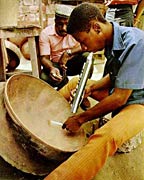Steel Pan Creation
How Steel Drums Are Made Making a Steel Drum is not easy! It can take years to learn the skills needed to turn an old steel barrel into a living musical instrument.

Steel Drums are all hand-made, and every panmaker will spend years in apprenticeship to learn how to make one properly. A single pan might take up to 5 days or more to make, and cost upwards of $1500 (US)! So what goes into crafting such a unique instrument?
First, a 55-gallon drum is selected for the quality of its steel. A large metal hammer is then applied to the bottom of the barrel, stretching the metal into a concave bowl or dish shape. This is called "sinking the pan" and is the noisiest and most physically exhausting part of the process. It is very important to stretch the metal evenly without tearing it or deforming the rim. Sinking a pan can take 5 hours or more of (very loud) hammering!
After sinking the pan, the steel must then be tempered to increase the resilience and strength of the metal. Using a fire or a torch, the pan is heated until the metal glows red-hot. At just the right moment, the metal is rapidly cooled off with a splash of water or a quick dunk in the ocean. This process (called tempering) makes the metal much stronger, and the barrelhead is now able to withstand the rigors of the tuning process.
A template is used to mark the placement of each note on the sunken head of the drum. Lines are drawn in pencil to guide the tuner's hammering. Each note outline is then "grooved" using a nail punch and a hammer. Grooving the notes make the notes more visible and also isolates each note's vibration somewhat from the other notes on the drum. It is very important not to weaken or break the metal with the nail punch during the grooving process.

Depending on the type of pan being made, the barrel's side (or "skirt") is cut with a chisel to the proper length, and holes are drilled near the rim so the pan can hang from a stand with wire or rope. The panmaker takes his hammers of various sizes and "pongs" the traced notes up from beneath, making them stand out like bubbles from the interior of the pan. This gives the note the approximate tension and shape it needs to vibrate at the correct pitch.
Next, the panmaker uses a tuning device, like a melodica or a stroboscope, and carefully hammers at each note from the top, stretching and smoothing the note area so that it will vibrate precisely. Each individual note on the drumhead must be tuned in relation to the other notes, or the pan will not "sing" correctly. Often a panmaker will tune each note several times before the whole pan is fully "blended" together and "all the molecules are running in a line" (as our pan-maker Boots says).
Finally, the finished pans are either painted in bright colors or dipped in chrome to make them shine like silver. The hot chrome bath detunes the drum slightly, so it must be tuned again after chroming. Once the drum is checked and hung, it's ready for playing!
If you'd like to try your hand at creating one of these cool instruments, our How To Make A Pan page tells you how to get started with a simple version that anyone can try. (Make A Pan!)
If you're interested in purchasing a steel drum, our Links page has a list of manufacturers and suppliers you can check out. (Pan Links)
The Sticks!
Steel drum mallets (often called "sticks") are usually made from either wooden dowels or aluminum tubing. For the smaller pans, the mallets are tipped with rubber surgical tubing, or sometimes just a rubber band wrapped tightly around the end of the stick.
Larger pans need more weight on the mallets, so players will shave down a solid rubber ball (the best kind is the Super Pinky) to the right size and glue it on to the end of a stick to create a larger mallet.
Every pan player is responsible for his or her own sticks, so keep a close eye on them or they might disappear just when you need them the most!
Brought To You By The Toucans
This original content is ©1995-2010 by the Toucans Steel Drum Band. Please represent the Toucans as the original author if you quote parts of this article elsewhere. This article may not be reprinted in full without permission.

















